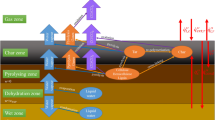Abstract
To improve the perceived equivalency of fire testing of combustible and non-combustible members we have proposed a simple modification in the fire resistance test procedure by introducing a lower limit of the heat release rate of the furnace. With this approach the combustion of the sample adds to the heat of the furnace, which is in contrary to current approach and does increase the severity of the test. To quantify the consequences, three wall assemblies were tested with pre-defined heat release curves and modified furnace conditions. The assemblies were timber walls built from two layers of Oriented Strain Boards (OSB, 25 mm thick) on a timber frame with an air cavity (100 mm). A reference experiment with a well-insulated wall was performed to determine the furnace’s minimum heat release rate (HRR) required to maintain the standard (ISO 834) temperature/time curve. The first wall was tested with a standard fire resistance test, and in the 2nd and 3rd wall experiment, the furnace followed the minimum HRR value determined in a reference experiment. In experiment 2, the furnace ventilation matched the air requirements of the burners, and in experiment 3, the furnace was over ventilated. Peak temperatures measured in experiments 2 and 3 exceeded the standard temperature/time relation by 420°C and 600°C, respectively. The assembly’s failure (integrity criterion) was observed after 27 min, 23 min and 14 min of experiments 1, 2 and 3, respectively. The limitations of the approach used related to reproducibility and validity are discussed.











Similar content being viewed by others
References
Babrauskas V, Williamson R (1978) The historical basis of fire resistance testing — Part I. Fire Technol 14:304–316
Babrauskas V, Williamson RB (1978) The historical basis of fire resistance testing — Part II. Fire Technol 14:304–316
Bisby L, Gales J, Maluk C (2013) A contemporary review of large-scale non-standard structural fire testing. Fire Sci Rev 2:1
Gales J, Chorlton B, Jeanneret C (2021) The historical narrative of the standard temperature-time heating curve for structures. Fire Technol 57:529–558
CEN (2012) EN 1363–1:2012 Fire resistance tests. General requirements
Wickström U (2011) The adiabatic surface temperature and the plate thermometer. Fire Saf Sci. https://doi.org/10.3801/IAFSS.FSS.10-1001
Lange D, Boström L (2017) A round robin study on modelling the fire resistance of a loaded steel beam. Fire Saf J 92:64–76
Węgrzyński W, Turkowski P, Roszkowski P (2020) The discrepancies in energy balance in furnace testing, a bug or a feature? Fire Mater 44:311–322
Internationaltimber.com (2015) How does timber handle fire compared to steel and concrete? https://internationaltimber.com/resources/how-does-timber-handle-fire-compared-to-steel-and-concrete/
Ambrahamsen R Get used to wooden skyscrapers. They’re stronger, cleaner and fire resistant. https://www.euronews.com/2018/05/04/get-used-to-wooden-skyscrapers-they-are-stronger-cleaner-and-fire-resistant-view
Economist Mass Timber: Wood is prominent in construction’s future, value for carbon removal to be determined. https://carbonremoval.economist.com/mass-timber/
Law A, Hadden RM (2020) We need to talk about timber: fire safety design in tall buildings. Struct Eng. https://www.istructe.org/journal/volumes/volume-98-(2020)/issue-3/we-need-to-talk-about-timber-fire-safety-design-in/. Accessed 11 Mar 2022
Law A, Hadden RM (2017) Burnout Means Burnout. SFPE Eur Q1. https://www.sfpe.org/page/Issue5Feature1. Accessed 11 Mar 2022
Kawagoe K, Sekine T (1963) Estimation of fire temperature-time curve in rooms, Second Report. Occasional Report No. 11, Building Research Institute, Japan
Babrauskas V, Williamson RB (1978) Post-flashover compartment fires: basis of a theoretical model. Fire Mater 2:39–53
CEN (2002) EN 1991–1–2 Eurocode 1: actions on the structures - Part 1–2: general actions - Actions on the structures exposed to fire
Brandon D, Sjöström J, Hallber E, Temple A, Kahl F (2020) RISE Report 2020:94 Fire Safe implementation of visible mass timber in tall buildings – compartment fire testing
Jonsdottir AM, Rein G (2009) Out of range. Fire Risk Management, Dec., 14–17
Wickström U (2020) Comments on - On some issues with the fire resistance testing. SFPE Eur Q1. https://www.sfpe.org/publications/sfpeeuropedigital/sfpeeurope17/issue17feature4. Accessed 11 Mar 2022
Maluk C, Linnan B, Wong A, Hidalgo JP, Torero JL, Abecassis-Empis C, Cowlard A (2017) Energy distribution analysis in full-scale open floor plan enclosure fires. Fire Saf J. https://doi.org/10.1016/j.firesaf.2017.04.004
Schmid J, Brandon D, Werther N, Klippel M (2018) Technical note - Thermal exposure of wood in standard fire resistance tests. Fire Saf J. https://doi.org/10.1016/J.FIRESAF.2018.02.002
Bartlett AI, McNamee R, Robert F, Bisby LA (2019) Comparative energy analysis from fire resistance tests on combustible versus noncombustible slabs. Fire Mater fam. https://doi.org/10.1002/fam.2760
Lange D, Sjöström J, Schmid J, Brandon D, Hidalgo J (2020) A comparison of the conditions in a fire resistance furnace when testing combustible and non-combustible construction. Fire Technol 56:1621–1654
Richter F, Kotsovinos P, Rackauskaite E, Rein G (2021) Thermal response of timber slabs exposed to travelling fires and traditional design fires. Fire Technol 57:393–414
Bartlett AI, Hadden RM, Bisby LA (2019) A review of factors affecting the burning behaviour of wood for application to tall timber construction. Fire Technol 55:1–49
Frangi A, Fontana M (2003) Charring rates and temperature profiles of wood sections. Fire Mater 27:91–102
Wiesner F, Bartlett A, Mohaine S, Robert F, McNamee R, Mindeguia J-C, Bisby L (2021) Structural capacity of one-way spanning large-scale cross-laminated timber slabs in standard and natural fires. Fire Technol 57:291–311
CEN (2020) EN 1363–1:2020. Fire resistance tests. General requirements
Funding
This research was funded by the Building Research Institute statutory grant financed by the Ministry of Science and Higher Education, grant number NZP-128/2020.
Author information
Authors and Affiliations
Corresponding author
Additional information
Publisher's Note
Springer Nature remains neutral with regard to jurisdictional claims in published maps and institutional affiliations.
Rights and permissions
About this article
Cite this article
Turkowski, P., Węgrzyński, W. Comparison of a Standard Fire-Resistance Test of a Combustible Wall Assembly with Experiments Employing Pre-defined Heat Release Curves. Fire Technol 58, 1767–1787 (2022). https://doi.org/10.1007/s10694-022-01226-1
Received:
Accepted:
Published:
Issue Date:
DOI: https://doi.org/10.1007/s10694-022-01226-1




